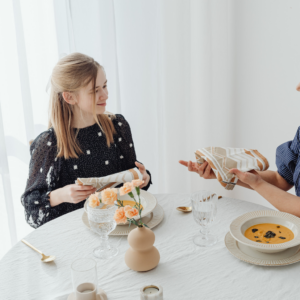

Dining etiquette matters because it reflects your respect for others and the setting. Whether you’re attending a business luncheon, a formal dinner, or a casual gathering, knowing how to use a napkin properly can set you apart and save you from embarrassment. According to a survey by the Emily Post Institute, 85% of respondents believe that good manners positively impact professional and personal relationships. This reinforces the idea that mastering dining etiquette is not just about following rules but about fostering better interactions and relationship.
One of the first rules of napkin etiquette is placing your napkin on your lap as soon as you are seated. This small action signals to others that you are prepared and aware of dining norms. Failing to do so can make you appear inattentive or inexperienced.
Placing your napkin on your lap immediately serves two purposes: it protects your clothes from accidental spills and shows your understanding of proper dining conduct. In professional settings, such attention to detail can contribute to a positive perception of your overall demeanor and professionalism.

A napkin is meant for dabbing your mouth and fingers, not for personal hygiene tasks like blowing your nose. This behavior is considered highly inappropriate and unhygienic in any dining setting.
Using a napkin inappropriately can make others uncomfortable and disrupt the dining experience. It’s important to excuse yourself from the table if you need to blow your nose or attend to other personal matters. This respect for communal dining spaces helps maintain a pleasant atmosphere for everyone.
When you need to leave the table temporarily, fold your napkin loosely and place it on your chair, not on the table. A soiled napkin on the table is unsightly and can be off-putting to other diners.
Keeping the table clean and orderly is part of good dining etiquette. By placing your napkin on your chair, you show consideration for your fellow diners and the overall dining experience. This small act of courtesy can contribute to a more refined and enjoyable meal for everyone.
Ignoring the napkin entirely is a common faux pas. Your napkin is there to keep you tidy, so use it to dab your mouth and fingers as needed. Not using it can make you appear careless or unrefined.
Using your napkin appropriately helps you maintain a neat appearance throughout the meal. This is particularly important in professional settings where your attention to detail is under scrutiny. Demonstrating good napkin etiquette shows that you are considerate and well-mannered.
At the end of the meal, place your napkin neatly to the left of your plate. Leaving it on your chair can be confusing for the host and staff, as it might suggest you are returning.
Properly signaling the end of your meal is an important part of dining etiquette. Placing your napkin to the left of your plate indicates that you have finished eating and helps the host and staff understand your intentions. This clear communication through your actions ensures a smooth and respectful dining experience.
Mastering napkin etiquette is a simple yet impactful way to enhance your dining manners. By avoiding these common napkin faux pas, you demonstrate respect for your dining companions and an understanding of social norms. Remember, small details like these can significantly affect how you are perceived in both personal and professional settings. So, the next time you’re at a dining event, keep these tips in mind to make a positive impression.
For more tips on dining etiquette and professional development, explore our resources at Manners with Kristina. Start your journey to refinement today and become the best version of yourself.
Take the first step towards improving your social and professional skills. Our free consultation will provide you with tailored advice and insights to help you achieve your goals. Don’t wait—book your session today and begin your transformation!
Subscribe to our monthly newsletter for the latest news, updates, and expert tips. Choose one category that interests you the most and become a better version of yourself today!
By subscribing you agree to our Privacy Policy.
Kristina Szabova is a certified Etiquette Consultant and member of the International Association of Professional Etiquette Consultants.
Each book is packed with practical tips and expert advice. Perfect for those looking to refine their skills and elevate their everyday interactions.
Learn at your own pace with our online courses offer. Unlock your potential with expert-led training from the comfort of your home.
Achieve your goals with personalized one-on-one coaching. I’m here to support you every step of the way.
Shop our collection of stylish and functional products, including diaries, calendars, and tea sets.
| Cookie | Duration | Description |
|---|---|---|
| cookielawinfo-checkbox-analytics | 11 months | This cookie is set by GDPR Cookie Consent plugin. The cookie is used to store the user consent for the cookies in the category "Analytics". |
| cookielawinfo-checkbox-functional | 11 months | The cookie is set by GDPR cookie consent to record the user consent for the cookies in the category "Functional". |
| cookielawinfo-checkbox-necessary | 11 months | This cookie is set by GDPR Cookie Consent plugin. The cookies is used to store the user consent for the cookies in the category "Necessary". |
| cookielawinfo-checkbox-others | 11 months | This cookie is set by GDPR Cookie Consent plugin. The cookie is used to store the user consent for the cookies in the category "Other. |
| cookielawinfo-checkbox-performance | 11 months | This cookie is set by GDPR Cookie Consent plugin. The cookie is used to store the user consent for the cookies in the category "Performance". |
| viewed_cookie_policy | 11 months | The cookie is set by the GDPR Cookie Consent plugin and is used to store whether or not user has consented to the use of cookies. It does not store any personal data. |